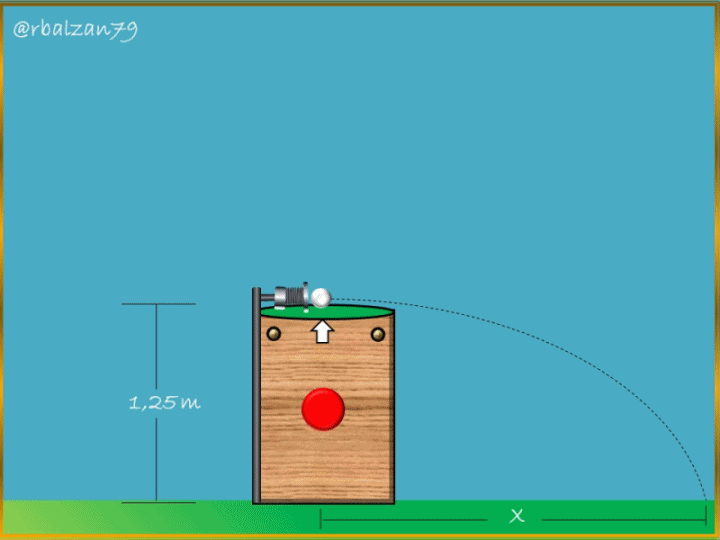Calculation of the horizontal distance of a semi-parabolic motion
0 comments

In the previous article we were able to relate to the calculation of the distance of a complete parabolic motion and, this time we will do it, but with a semi-parabolic motion as the one you see in the gif at the beginning of this presentation, there are many examples like this and we can also contribute to its development, therefore, we can say that the phenomenon of movement can be carried out in a natural and artificial way, then my dear friends to continue expanding our knowledge in relation to the phenomenon of movement, especially the parabolic, I leave you the following approach or statement.
Exercise
By means of the implementation of an innovative device, a small ball is launched, this device is placed horizontally on a small cylindrical wooden support at a height of 1.25 meters from the ground, this device when hitting the small ball gives it an initial velocity of 2.4 m/s, therefore, in relation to the above, answer the following question:
a.- What will be the distance reached by the ball when describing a half parabola?
Solution
Data:
Vox = 2.4 m/s (Initial ball velocity).
θ = 0° (Launch angle).
Y= - 1.25 m.
g = 9.8 m/s2.
X = ? (Distance traveled by the ball).
a.- Before starting with the respective calculations, it is important to remember that in a parabolic launch we must consider both the horizontal Vox and vertical Voy components of the initial velocity, as long as the firing angle is different from zero, therefore, in relation to the above we can say that in a semi-parabolic motion the path is half of the path of a full parabolic motion as you can see in the following figure 1.
a.- Before starting with the respective calculations, it is important to remember that in a parabolic launch we must consider both the horizontal Vox and vertical Voy components of the initial velocity, as long as the firing angle is different from zero, therefore, in relation to the above we can say that in a semi-parabolic motion the path is half of the path of a complete parabolic motion.
For the case of a semi-parabolic motion the initial velocity vector will be parallel to the X-axis, therefore, there is no inclined firing angle, or it is equal to zero (0), this leads us to work with the X-axis component, that is why the initial velocity indicated represents the horizontal component velocity Vox, this leads us to use the following formulation or equation 1.

We use this equation 1, because the horizontal movement carried out by the small ball is not subjected to any kind of acceleration, hence we implement the equation of uniform rectilinear motion, to apply this equation 1, we must know the time which so far we do not know, for this, we can use the following formulation 2.

From this formulation 2 we can clear the time (t), noting that the variables representing the vertical component (Voy. Senθ) is equal to zero, thus we are left with the following formulation 3.

With this formulation 3, we can know the time that implements the small ball to travel the semi-parabolic trajectory and, with this time (t), then, we can calculate the required or requested distance, therefore, we proceed to perform such calculations by means of formulation 1.

With this time value we proceed to substitute it in 1, in order to find the required distance of the semi-parabolic motion.

In this way we were able to know the distance or range achieved by the small ball when it was propelled by the device described in the previous gif, and whose path was that of a semi-parabola.
Conclusion
Physical science and mathematics teach us in different ways the importance of the interpretation of each of the phenomena that are found or developed at our side, as is the case of the wonderful and essential phenomenon of movement, and this phenomenon can be found or described in relation to the trajectory described by a particle, body or object, as we noticed with this small ball to describe a semi-parabolic trajectory, where we know the horizontal range of the same.
In this way we continue relating with the phenomenon of the movement in its semi-parabolic version, later we will continue analyzing other important variables related to this type of movement and, in addition we will relate with other important practical examples where we will be able to apply the physical science and mathematics as we were able to do in the present article.
Until another opportunity my dear friends.
Note: The images were created by the author @rbalzan79 using Power Point and Paint, the animated image was created using the PhotoScape application.
Recommended bibliographic references
[1] TIRO PARABOLICO. Link.
[2] El movimiento rectilíneo. Link.
[3] Projectile Motion. Link.
Comments